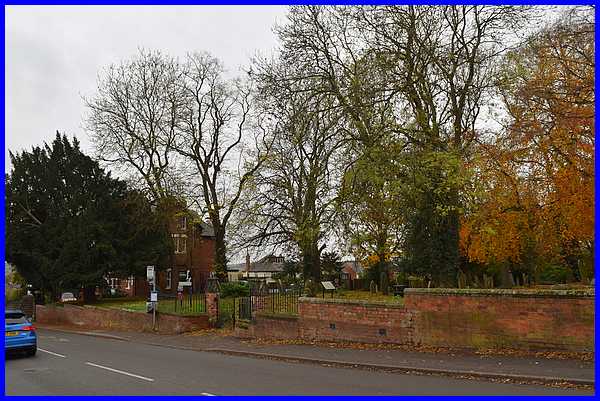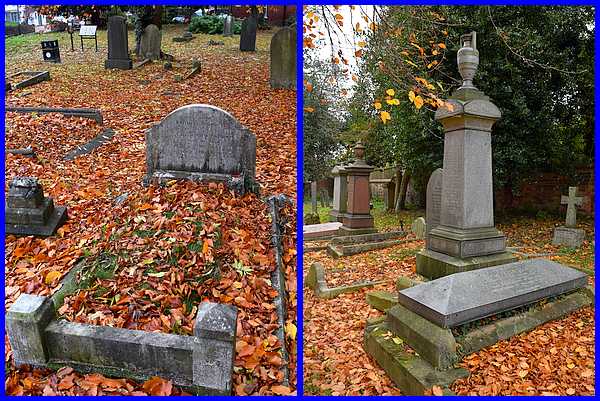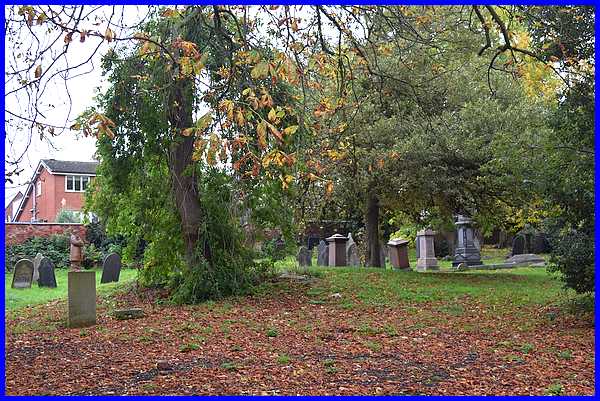Town Walk 2025 - Part 05 - To Stanton Road Cemetery
w/e 16 November 2024
All of this week's pictures were
taken with a Nikon D3300 camera
This part equates to an alternative route between
Stage 07 of the original Town Walk from 2003.

In 2003 on the original Town Walk, we approached this point from
the opposite direction but the view of the Catholic Church as
we approach from Gnome Island is little changed. The Our Lady
and St Thomas of Hereford Catholic Church, to give it its full
name, that replaced an earlier chapel, was built between 1921
and 1930. What is noticeable between this image and the earlier
one, is the change in the appearance of Yeomans on the corner
of Havelock Street which I mistakenly called Field Road in 2003.
Havelock Street is an L-shaped road that leads to Stanton Road
and Field Road leads off to a new housing estate built of part
of the former South East Derbyshire College site. It was probably
the new estate and the anticipated increase in traffic that resulted
in a modification to this road junction too. Another obvious
change of course is the traffic on Nottingham Road which is often
seen as a standstill between Gnome Island and the end of Chalons
Way!
|

At the far end of Havelock Street on the corner of Stanton Road
is the building that housed Ilkeston's first purpose built
Fire Station. I'm not sure of its use in 2003 but between then
and now it was occupied by the East Midlands Medical Services
Ltd although they have now moved to the former Pewit Golf Course
site.
|

As with the 2003 walk we are again making a detour down Stanton
Road to the non-denominational cemetery that opened in
1866. Beyond the cemetery is The Pines Nursery, formerly a Youth
Club attended by one of the town's famous sons, actor Robert
Lindsay. I'm devoting the rest of this page and the images to
the cemetery though and am relying heavily on a leaflet produced
some years ago by the Friends of Stanton Road Cemetery which details
"A walk through a fascinating Victorian burial ground."
|

Probably the most famous occupant of the cemetery is Samuel Taylor,
the Ilson Giant, and here once again I would refer you to Stage 7 of the original walk where I also mentioned
builder George Henry Manners and cricketer James Tilson with
images of their headstones. The walk follows an anticlockwise
route around the oblong site and these first three headstones
are along the northern edge of the site. From left to right they
are Abbot Thurman, a solicitor who owned The Pines; Charles Gregory,
a merchant seaman who took over The Old Wine Vaults on East Street;
and William and Elizabeth Bennett, earlier publicans of the Wine
Vaults.
|

The grave of another publican, Aaron Aldred, landlord of the
Queen's Head on Bath Street, lies diagonally across from Captain
Gregory's and the tall headstone with the urn on top marks the
last resting place of businessman Herbert Tatham. Mr Tatham was
a partner in the Needle Factory on Belper Street and the cross
behind his grave makes the grave of Dr John Tobin, Ilkeston's
Medical Officer of Health.

There are three distinct areas in the cemetery as in Victorian
times, burial plots had to be purchased with the most expensive
being nearest to Stanton Road and the least expensive at the
far end. "Second class" spots are in the middle and
it was in this middle section that the wooden statue of the Ilson
Giant was erected. Burials in the Stanton Road Cemetery ceased
in the 1940s.
|

At the far end of the cemetery by a Yew tree, seven year old
James Wilkinson was buried following a tragic accident on Bonfire
Night when he was wounded by a gun, the wound became infected
leading to he death. Another tragic accident led to the death
of Benjamin Briggs who was killed at Manners Colliery and he
is buried on the southern side of the cemetery. His headstone
stands next to one of the War Graves that have now been installed
in the cemetery.
|

The "Third Class" area of the cemetery is now
a haven for wildlife and in the spring it is awash with the colour
of crocuses. As we continue the walk along the southern side
of the cemetery, the Giant can be seen on the far side and in
between is a mound in the centre. This is all that remains of
the turning circle for horses that carried the coffins.
|

Near the mound is the grave of Leon Trouselle, a 28 year old
Frenchman who worked as a cook and died at Shipley Hall in 1879.
His mother had the original headstone erected but the leaflet
says that it was "recently renewed by the Friends of"
the cemetery.
|

The leaflet also advises visitors to the cemetery to look out
for symbolism on the memorials such as the clasped hands on that
of married couple Mary and Thomas Martin and the Dove of Peace
on Deborah Davies and Jackie Webster's headstone.
|

Health and safety at work was not as prominent in the 1800s and
early 1900s as it is today and there are several victims of industrial
accidents buried in the cemetery. As we near the completion of
our circuit through the cemetery two headstones record two tragedies.
On the left above the headstone records that John Pollard was
accidentally killed whilst working on the Great Northern Railway
in 1902. He was 55 but Arthur Norman's headstone (on the right
above) shows that he was only 17 in 1891 when he was killed following
an accident at Oakwell Colliery.
It seems fitting that our walk here took place in the Remembrance
month of November but as we leave the cemetery and continue the
Town Walk, it's with thanks again to the Friends for much of
the information above.
|












